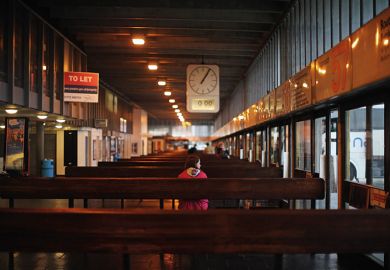When the judging panel picking the UK City of Culture 2021 came to Sunderland, those leading the bid ensured that they stayed in a hotel with views of the coast. That Sunderland has a coastline of any kind would surprise ignorant first-time visitors, let alone one like the expanse of sand and crashing waves from Roker to Seaburn, bleakly beautiful on a windswept early spring day. The artist L. S. Lowry spent his summer holidays at Seaburn, painting seascapes and the Sunderland shipyards, vanished along with its mines in the UK’s era of breakneck-speed deindustrialisation.
Coventry may have won the City of Culture title, but being one of the five shortlisted cities left a legacy for Sunderland. The partners on the bid – the University of Sunderland, Sunderland City Council and Sunderland Music, Arts and Culture Trust – decided to keep working together and formed Sunderland Culture.
The joint venture manages five venues owned by the partners and aims to establish a cultural quarter in the city centre, including a new £8.2 million venue for music, drama and dance. The plan is to build all this into a cultural package that will attract more visitors and “improve life for everyone in Sunderland” by enhancing the city’s “economic and social development”.
As UK universities increasingly prioritise their roles in their cities and towns, and austerity-hit councils look to them for support, the University of Sunderland culture project is a new kind of university civic mission.
Sunderland Culture can bring a “benefit in terms of visitors and tourism, but there’s also a benefit for the confidence of the city”, said Sir David Bell, who took over as Sunderland vice-chancellor in September, after leaving the University of Reading and previously serving as permanent secretary in the Department for Education.
Other key civic fronts for the university include the opening of its medical school this autumn – a huge step for both university and city – and its role in taking local students and helping them on to good jobs in the region. Overall, 85 per cent of Sunderland students are from the north east and 45 per cent start as mature students (aged over 21), while more than 30 per cent are from the poorest neighbourhoods. “The social mobility is not about them leaving the area,” said Sir David, criticising higher education policies that reward the universities whose graduates move to big cities with higher earnings and recognise “social mobility” only in the small number of poorer students getting into the most selective universities.
“While every university wants to talk of itself as an anchor institution…you get a real sense that this is a very important part of the civic infrastructure here,” said Sir David.
Sunderland has come to greater prominence recently through the success of the Netflix series Sunderland ’Til I Die, a behind-the-scenes documentary on the city’s football club which tells the story of its shattering Championship relegation season, and also of the wider community. It is a place where “not many people have had it easy” after the collapse of shipbuilding and mining, a “working-class city” where the football club is at the heart of people’s identities, one supporter explains in the opening episode. “This isn’t Watford or Cambridge.”
The scale of the city’s challenges makes the university’s civic role particularly pressing. Although the shift to online retailing has hit many British city centres hard, Sunderland’s is the image of a deserted ghost town on a Tuesday evening. One of the rows of shops next to the train station features, in succession, The Clearance Outlet (closed down), Kwik Tan, Admiral Casino and Poundland.

Just 27 per cent of Sunderland’s working-age population have a qualification at Level 4 (between A level and degrees) or above, putting it 53rd out of 63 UK cities on that score, according to Centre for Cities comparative data.
In the European Union referendum, Sunderland followed the pattern for deindustrialised areas to return Leave votes. National media have trooped to Sunderland, prominent as the first constituency to declare a Leave vote on referendum night, to portray it as the city that “defined Brexit”.
Japanese carmaker Nissan is a key local employer at its plant northwest of the city, but recently dealt a blow when it abandoned plans to make its X-Trail model at Sunderland.
The city’s image, inside and outside Sunderland, is one aspect that Sunderland Culture aims to address. The project has five aims to deliver on: “improved profile and reputation of the city”; a “more vibrant creative economy”; “raised outlook and aspiration of young people”; “improved health and wellbeing”; and “a more socially cohesive city”.
The plan is to build on Sunderland’s existing attractions: a city by the sea, with the Sunderland Museum and Winter Gardens (currently showing a Leonardo da Vinci exhibition), the Empire Theatre (with a stage big enough to host West End shows such as War Horse) and the university-owned National Glass Centre on the banks of the River Wear. The last is a celebration and continuation of the city’s glassmaking heritage: a tourist destination – where you can see glass being blown and learn how ships in bottles, a Sunderland speciality, are made – home to the university’s glass and ceramics department (the largest in Europe) and home to the Northern Gallery for Contemporary Art.
Can culture really improve life for people in Sunderland, beyond bringing in some extra tourists? Keith Merrin, chief executive of Sunderland Culture, said that the project is “not overpromising”. But greater access to theatre, the arts and museums could bring “greater confidence and aspiration” for the city’s school pupils, he argued. And developing a stronger creative economy could help keep more graduates in Sunderland, he added.
Sunderland Culture has won funding from Arts Council England, whose chief executive, Darren Henley, said that universities were increasingly important as “custodians of arts and culture in their places” and “Sunderland is a really strong example of this”.
There were benefits to universities in making their cities “great places to study and for academics to come and work”, but also in “reaching out into their communities” and not being institutions “separate from [their] place”, Mr Henley said.
He continued: “I believe very passionately that the arts, culture more generally – museums, libraries, galleries – should be open to absolutely everybody in this country, no matter where they live…Some people might say ‘why Sunderland?’ I would say ‘why not?’”
Patrick Melia, chief executive of Sunderland City Council, said that the culture plan meshed with the council’s plan to create a “vibrant” city centre by doubling the number of people living there to 5,000 and bringing 6,000 new office-based jobs.
Although the lost jobs in shipbuilding and mining have largely been replaced, these jobs are outside the city, “which meant the city centre itself has suffered and stagnated”, said Mr Melia.
He talked about “bringing the university more into the heart of the city” and creating more housing “on the back of the university”, which would in turn lead more graduates to stay in Sunderland. “The university can provide a real lifeblood in the city to make it feel and look different to the way it does today,” said Mr Melia.
On other key civic fronts for the university, Sir David said that the move to open a medical school “feels quite countercultural”, given that these were the preserve of Russell Group universities until relatively recently. The north east currently has the lowest rate of applications to medical school of any UK region, he added.
For the coming academic year, 45 per cent of applications have been in health-related disciplines including paramedic science, nursing and pharmacy, said Sir David, showing that the university is “very much addressing a skills need in the area”.
Teacher education is another area where the university aims to have an impact in the region and provide local students with good local jobs. Lynne McKenna, dean of the Faculty of Education and Society, and a Sunderland graduate, said the university had a “partnership approach” involving “going out to schools asking them what their needs are”, offering “bespoke services for the city of Sunderland”.
The government’s post-18 education review raises big issues for Sunderland and Sir David said that he has been “really open” with staff about the potential impact.
A £6,500 fee cap with no Treasury top-up would “cost us about £19 million, around a 14 per cent cut”, while a £7,500 cap would mean a £14 million or 9 per cent cut, he said.
Overall, Sir David called for policymakers to take “a more nuanced view of what a university like this does”.
He added: “I think it’s brilliant this country has such a diverse range of institutions…Oxford, Cambridge, Imperial, Manchester – these are globally recognised, outstanding institutions that do so much for the country. Actually so are the Sunderlands, the Teessides, the Northumbrias, etc – we are equally making an incredibly strong contribution to the health of the nation.”
Register to continue
Why register?
- Registration is free and only takes a moment
- Once registered, you can read 3 articles a month
- Sign up for our newsletter
Subscribe
Or subscribe for unlimited access to:
- Unlimited access to news, views, insights & reviews
- Digital editions
- Digital access to THE’s university and college rankings analysis
Already registered or a current subscriber?








